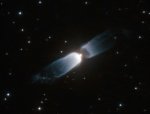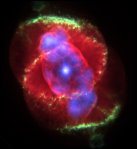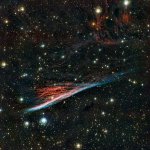

Bottom left: An example of a planetary nebula – the Helix nebula.
Bottom right: An example of a supernova remnant – SN 1006.
Because astronomy is an observation-based science, we need to carefully categorize the objects we see. As we explore the cosmos, we discover that not all objects are the same, and even then, some objects that appear the same at first glance differ greatly in the details.
Here, we will be discussing the classifications we give the objects we find.
A nebula is basically a large cloud of gas – in that, there are several different categories that define the type of nebula we are viewing.
Today, I wanted to talk about protoplanetary nebulae, planetary nebulae, and supernova remnants. Unlike the other nebulae we have talked about, these three objects are stages in stellar evolution forming a nebulous body in the process.
Firstly, it’s important to note that neither protoplanetary nebulae nor planetary nebulae have anything to do with planets. When early astronomers viewed planetary nebula, they noticed a similar appearance between these objects and the planet Uranus. Because of this, the nebulae were called ‘planetary’ and the name stuck; even though we now know they are completely different from planets. Protoplanetary nebulae are simply the objects that happen before the planetary stage. With that being said…

Image Credit: ESA/Hubble & NASA
Protoplanetary nebulae are objects with extremely short life span (less than 10,000 years). This is one of the final stages of stellar evolution or, depending on how you want to look at it, you could say this is really the first stage of a star’s death. This part of stellar evolution is reserved for low-medium mass stars. Our own sun will pass through this stage is about 4-billion years. As the star evolves, it starts to eject its outer layers. In this stage, the star is heating up, but isn’t hot enough to fully ionize the surrounding gas. Eventually, the star produces enough energy to fully ionize the surrounding gas, which leads us rather smoothly into the planetary stage. IRAS 13208-6020 is an example of a protoplanetary nebula.

Image Credit: NASA
Planetary nebulae are a type of emission nebulae. Due to unknown processes, these nebulae take on a wide variety of shapes. Of the dozen or so shapes observed to date, the three most abundant types are spherical, elliptical, and bipolar. These objects also have a short lifespan of about 10,000 years. Because of that, there are only about 3,000 known planetary nebulae. Eventually, the central star that ionized the nebula cools down and becomes a white dwarf leaving these magnificent nebulae to fade away from sight. Again, this is the evolutionary track our sun is going to take. The Cat’s Eye nebula is an example of a planetary nebula.

Image Credit: NASA
Lastly, we have supernova remnants. I’m sure it’ll come as a great shock to you when I say these objects are the remnants of supernovae. When a massive star dies, it literally goes out with a bang and undergoes a thermonuclear explosion as the star collapses on itself. These cataclysmic events are some of the most destructive in the universe. The Pencil nebula is an example of a supernova remnant.
See the other articles in this series:
Classifications of Objects in Space Part 1: Emission Nebula
Classifications of Objects in Space Part 2: Reflection Nebula
Classifications of Objects in Space Part 3: Diffuse and Star-forming Nebulae